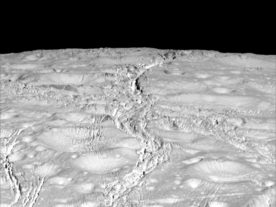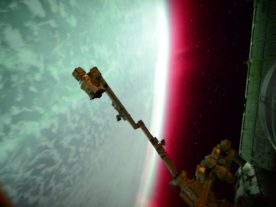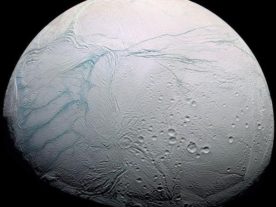Study: Dinosaurs Roamed Before Saturn’s Moons and Rings Formed
A new study from researchers at the SETI Institute (Search for Extraterrestrial Intelligence) and the Southwest Research Institute (SwRI) has found that most of Saturn’s 62 moons and perhaps even its celebrated rings may only be a hundred million years old. That’s more recent than when dinosaurs were roaming Earth. One of the study authors, Matija […]
October 2015 Science Images

A Close Look at Saturn Moon’s North Pole; Imitation Skin Senses Pressure
Cassini Explores North Pole Area of Saturn’s Moon Enceladus NASA’s Cassini spacecraft has been sending back spectacular images and providing scientists with valuable data about the Saturn and its many moons since its arrival there in 2004. On October 14th, Cassini returned to Saturn’s ice-covered and 6th largest moon Enceladus, the latest of many trips […]

June 2015 Science Images

Science Scanner: Milky Way Bigger than Thought, Hydrothermal Activity on Saturn Moon, New Way to Fight Cavities & Gum Disease, Dwarf Galaxy Surprises Scientists
Milky Way May Be Much Bigger than Thought Our galaxy, the Milky Way may be much bigger than previously thought, up to 50 light-years further across, say researchers. Researchers from the United States, China and the United Kingdom came to the conclusion after reviewing data gathered by the Sloan Digital Sky Survey (SDSS), an ongoing […]
Saturn Moon’s Wobble Could Be Clue to What’s Inside
Scientists with NASA’s Cassini Mission, which has been studying Saturn since 2004, were trying to figure out just how much one of its moons, Mimas, wobbled as it orbits the ringed planet. After reviewing and analyzing copious images snapped by the robotic probe and running several models, the scientists think the moon’s wobble could be […]
Science Images for September, 2014
Science Picture Blog
Saturn’s Rings Are Raining on Planet
The old adage “April showers bring May flowers” may take on new meaning with the release of a new NASA-funded study tracking the rain of charged water particles from Saturn’s famous rings into the planet’s atmosphere. The study, led by the University of Leicester, England, found there’s more of this rain and its spread over […]
